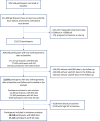Ultra-processed food consumption and risk of obesity: a prospective cohort study of UK Biobank
- PMID: 33070213
- PMCID: PMC8137628
- DOI: 10.1007/s00394-020-02367-1
Ultra-processed food consumption and risk of obesity: a prospective cohort study of UK Biobank
Abstract
Objective: The objective of this study was to examine the associations between ultra-processed food consumption and risk of obesity among UK adults.
Methods: Participants aged 40-69 years at recruitment in the UK Biobank (2006-2019) with dietary intakes collected using 24-h recall and repeated measures of adiposity--body mass index (BMI), waist circumference (WC) and percentage of body fat (% BF)--were included (N = 22,659; median follow-up: 5 years). Ultra-processed foods were identified using the NOVA classification and their consumption was expressed as a percentage of total energy intake. Multivariable Cox proportional hazards regression models were used to estimate hazard ratios (HR) of several indicators of obesity according to ultra-processed food consumption. Models were adjusted for sociodemographic and lifestyle characteristics.
Results: 947 incident cases of overall obesity (BMI ≥ 30 kg/m2) and 1900 incident cases of abdominal obesity (men: WC ≥ 102 cm, women: WC ≥ 88 cm) were identified during follow-up. Participants in the highest quartile of ultra-processed food consumption had significantly higher risk of developing overall obesity (HR 1.79; 95% CI 1.06─3.03) and abdominal obesity (HR 1.30; 95% CI 1.14─1.48). They had higher risk of experiencing a ≥ 5% increase in BMI (HR 1.31; 95% CI 1.20─1.43), WC (HR 1.35; 95% CI 1.25─1.45) and %BF (HR 1.14; 95% CI 1.03─1.25), than those in the lowest quartile of consumption.
Conclusions: Our findings provide evidence that higher consumption of ultra-processed food is strongly associated with a higher risk of multiple indicators of obesity in the UK adult population. Policy makers should consider actions that promote consumption of fresh or minimally processed foods and reduce consumption of ultra-processed foods.
Keywords: Cohort study; Food processing; Obesity; Ultra-processed food; United kingdom.
Conflict of interest statement
The authors declare that they have no conflict of interest.
Figures
References
-
- Ludwig DS. Technology, diet, and the burden of chronic disease. JAMA. 2011;305(13):1352–1353. - PubMed
-
- Moodie R, Stuckler D, Monteiro C, Sheron N, Neal B, Thamarangsi T, Lincoln P, Casswell S; Lancet NCD Action Group Profits and pandemics: prevention of harmful effects of tobacco, alcohol, and ultra-processed food and drink industries. Lancet. 2013;381(9867):670–679. - PubMed
-
- Vandevijvere S, Jaacks LM, Monteiro CA, Moubarac JC, Girling-Butcher M, Lee AC, Pan A, Bentham J, Swinburn B. Global trends in ultraprocessed food and drink product sales and their association with adult body mass index trajectories. Obes Rev. 2019;20(Suppl 2):10–19. - PubMed
MeSH terms
Grants and funding
- MC_QA137853/MRC_/Medical Research Council/United Kingdom
- MC_PC_17228/MRC_/Medical Research Council/United Kingdom
- 2018/26660-0/Fundação de Amparo à Pesquisa do Estado de São Paulo
- 2018/19820-1/Fundação de Amparo à Pesquisa do Estado de São Paulo
- 2015/14900-9/Fundação de Amparo à Pesquisa do Estado de São Paulo
LinkOut - more resources
Full Text Sources
Miscellaneous



